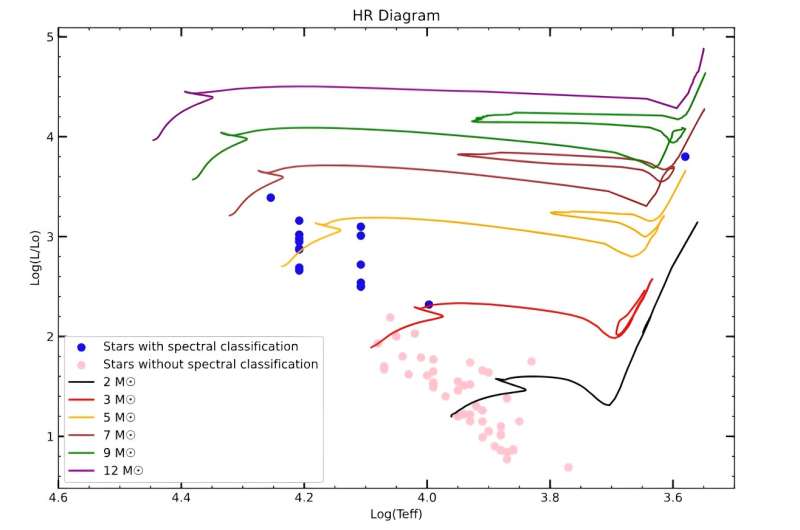April 16, 2024 report
This article has been reviewed according to Science X's editorial process and policies. Editors have highlighted the following attributes while ensuring the content's credibility:
fact-checked
preprint
trusted source
proofread
Astronomers inspect open cluster Berkeley 50

Using the Lowell Discovery Telescope (LDT), astronomers from the Lowell Observatory in Flagstaff, Arizona, have observed a young Galactic open cluster known as Berkeley 50. Results of the observational campaign, presented April 5 on the preprint server arXiv, shed more light on the properties and stellar content of this cluster.
Open clusters (OCs), formed from the same giant molecular cloud, are groups of stars loosely gravitationally bound to each other. So far, more than 1,000 of them have been discovered in the Milky Way, and scientists are still looking for more, hoping to find a variety of these stellar groupings. Studying OCs in detail could be crucial for improving our understanding of the formation and evolution of our galaxy.
Berkeley 50 (also known as IC 1310) is a poorly studied young Galactic open cluster located some 12,200-12,400 light years away. Previous observations have found that the cluster has a diameter of 7.0 arcminutes and its reddening is at a level of 0.97 mag.
A team of astronomers led by Lowell Observatory's Meghan Speckert decided to take a closer look at Berkeley 50 using LDT's Large Monolithic Imager (LMI), hoping to get more insights into the stellar content of this cluster. Their observations were complemented by data from ESA's Gaia satellite.
"Images were taken on the LDT using the Large Monolithic Imager (LMI). The imager consists of a single 92.2-mm by 92.4-mm e2v CCD231-C6 chip with a multilayer anti-reflective coating," the researchers wrote in the paper.
First, the team obtained photometry of 1,145 stars in the field of Berkeley 50. Then they used Gaia to determine potential membership of these stars and to select the ones suitable for spectroscopy.
The astronomers managed to conduct optical spectroscopy of the 17 brightest stars near a known supergiant star designated TYC 2679-0322-1, which is one of the central stars of Berkeley 50. Next, they classified the stars of this sample as mid-to-late B-type stars and one A0 star. Given that the proper motions and parallaxes of these stars were all similar, this allowed the researchers to establish 64 stars as certain cluster members.
"An inspection of the distribution of parallaxes of these proper-motion selected sample allowed us to impose a cutoff of 0.215 mas to 0.265 mas for the parallaxes of potential members. This reduced our sample of likely cluster members to 64 stars," the authors explained.
The study found that Berkeley 50 has a strong main sequence and that its most massive stars are about seven times more massive than the sun. The age of the cluster was estimated to be 50–60 million years, while its reddening was determined to be approximately 0.9 mag. The distance to the cluster was measured to be 12,400 light years, which is consistent with previous estimates.
More information: Meghan Speckert et al, The Stellar Content of the Young Open Cluster Berkeley 50 (IC 1310), arXiv (2024). DOI: 10.48550/arxiv.2404.04435
Journal information: arXiv
© 2024 Science X Network





















